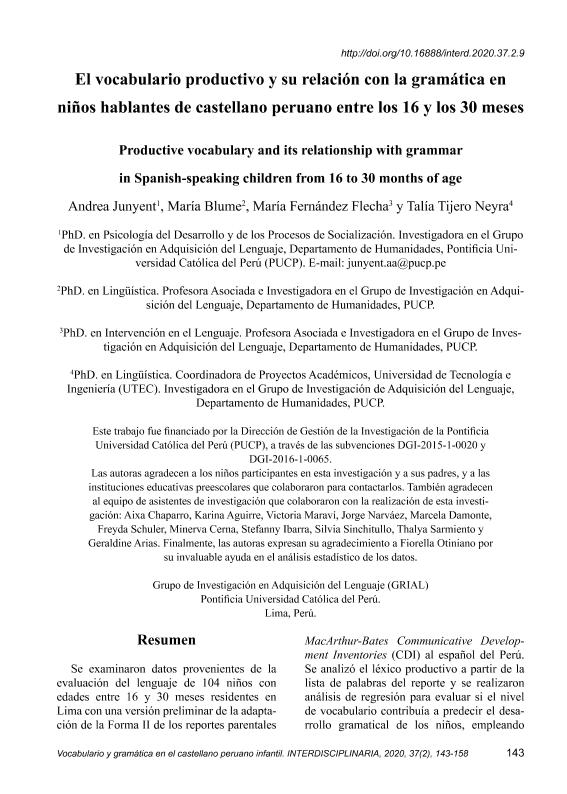Artículo
Se examinaron datos provenientes de la evaluación del lenguaje de 104 niños conedades entre 16 y 30 meses residentes en Lima con una versión preliminar de la adaptaciónde la Forma II de los reportes parentales MacArthur-Bates Communicative DevelopmentInventories (CDI) al español del Perú. Se analizó el léxico productivo a partir de la lista de palabras del reporte y se realizaron análisis de regresión para evaluar si el nivel de vocabulario contribuía a predecir el desarrollo gramatical de los niños, empleando como variables de control la edad del niñoy el nivel de escolarización materna (como indicador del nivel socioeconómico) y como variables dependientes la longitud media de los tres enunciados más largos (LME3) y la complejidad morfosintáctica (CM), obtenidas con el CDI. Los sustantivos fueron la clase de palabras más frecuente y que más aumentó con la edad, como en el italiano (Caselli et al., 1995; D?Odorico y Fasolo, 2007) y el español mexicano (Jackson-Maldonado et al., 1993). Además, el nivel de vocabulario predijo el nivel de desarrollo gramatical, como en el español peninsular (Mariscal y Gallego, 2012) y en el mexicano (Thal, Jackson-Maldonado y Acosta, 2000): una vez controlados losefectos de la edad y la escolarización materna, el vocabulario explicó el 20 % de la variabilidad de la LME3 y el 37 % de la variabilidad de la CM. Este estudio ofrece información sobre el desarrollo temprano del vocabulario y la gramática en el español del Perú, una etapa escasamente estudiada en esta variedad. We present results from the analysis of data from 104 children with ages ranging from 16 to 30 months, living in Lima, Peru. The data was collected using a preliminary version of the MacArthur-Bates Communicative Development Inventories (CDI), Form II, adapted to Peruvian Spanish. The CDIs are parental reports that assess language through the presentation of a series of items to the parents, mainly in the form of a checklist. We aimed to (1) describe the composition of Peruvian children's productive lexicon at this age, (2) identify whether nouns were the most frequent class in their vocabulary, and also the class which increased the most with age, as is the case in Italian (Caselli et al., 1995; D'Odorico y Fasolo, 2007) and Mexican Spanish (Jackson-Maldonado et al., 1993); and (3) assess whether vocabulary size explained the level of grammatical development as in Peninsular and Mexican Spanish (Mariscal & Gallego, 2012; Thal, Jackson-Maldonado & Acosta, 2000). In order to do so, we analyzed the following data: age; maternal education level (as an indicator of socioeconomic status); vocabulary (represented by a list of more than 500 words that parents recognized as produced or not by their children); the mean length of the three longest utterances produced by the child as reported by parents; and sentence complexity, a measure of the level of structures produced by the child based on the parent’s report. To achieve the first and second goals, words in the vocabulary list were classified according to grammatical class. Then, the percentage of production of each class of words was calculated, as well as the correlation between this percentage and age. Children’s vocabulary was composed mainly of nouns, which represented 57 % of the production, followed by predicates (verbs and adjectives) and function words (pronouns, determiners, prepositions, conjunctions and connectives). Noun was the class of words that increased the most with age, showing the highest correlation with such variable (r = .72). Correlations between other types of words and age varied: it was also high for adjectives; but moderate for some classes and low for others. This showed that each type of word increased at different rates. Regarding the third goal, to assess the relationship between vocabulary size and level of grammatical development, two regression analyses were conducted to predict the variables mean-length-of-the-three-longest-utterances and sentence-complexity. For both analyses, age and maternal education level were entered in the first step, in order to control for their effect; and vocabulary was entered in the second step. Both models accounted for substantial amounts of variance and showed an important effect on vocabulary. The model with the mean-length-of-the-three-longest-utterances as the dependent variable accounted for 56 % of the variance. The first step explained 37 % of the variance (due to the contribution of both age and maternal education level), and the second step explained an additional 20 %. The model with sentence-complexity accounted for a higher percentage of the variance, 75 %. The first step explained 38 % of the variance, exclusively due to age; while the second step explained an additional 37 %. These results suggest a strong relationship between vocabulary and grammar. Further research is needed to confirm these results with direct measures of child production and more representative samples of children acquiring Peruvian Spanish, including speakers of dialects of other parts of the country. However, these results, preliminary as they are, shed light on the composition of vocabulary and its relationship with grammar in a variety of Spanish scarcely studied during early stages of development.
El vocabulario productivo y su relación con la gramática en niños hablantes de castellano peruano entre los 16 y los 30 meses
Título:
Productive vocabulary and its relationship with grammar in Spanish-speaking children from 16 to 30 months of age
Fecha de publicación:
12/2020
Editorial:
Centro Interamericano de Investigaciones Psicológicas y Ciencias Afines
Revista:
Interdisciplinaria
ISSN:
0325-8203
e-ISSN:
1668-7027
Idioma:
Español
Tipo de recurso:
Artículo publicado
Clasificación temática:
Resumen
Archivos asociados
Licencia
Identificadores
Colecciones
Articulos(CIIPME)
Articulos de CENTRO INTER. DE INV. EN PSICOLOGIA MATEMATICA Y EXP. "DR. HORACIO J.A RIMOLDI"
Articulos de CENTRO INTER. DE INV. EN PSICOLOGIA MATEMATICA Y EXP. "DR. HORACIO J.A RIMOLDI"
Citación
Junyent Moreno, Andrea Anahí; Blume, María; Fernández Flecha, María; Tijero Neyra, Talía; El vocabulario productivo y su relación con la gramática en niños hablantes de castellano peruano entre los 16 y los 30 meses; Centro Interamericano de Investigaciones Psicológicas y Ciencias Afines; Interdisciplinaria; 37; 2; 12-2020; 143-158
Compartir




